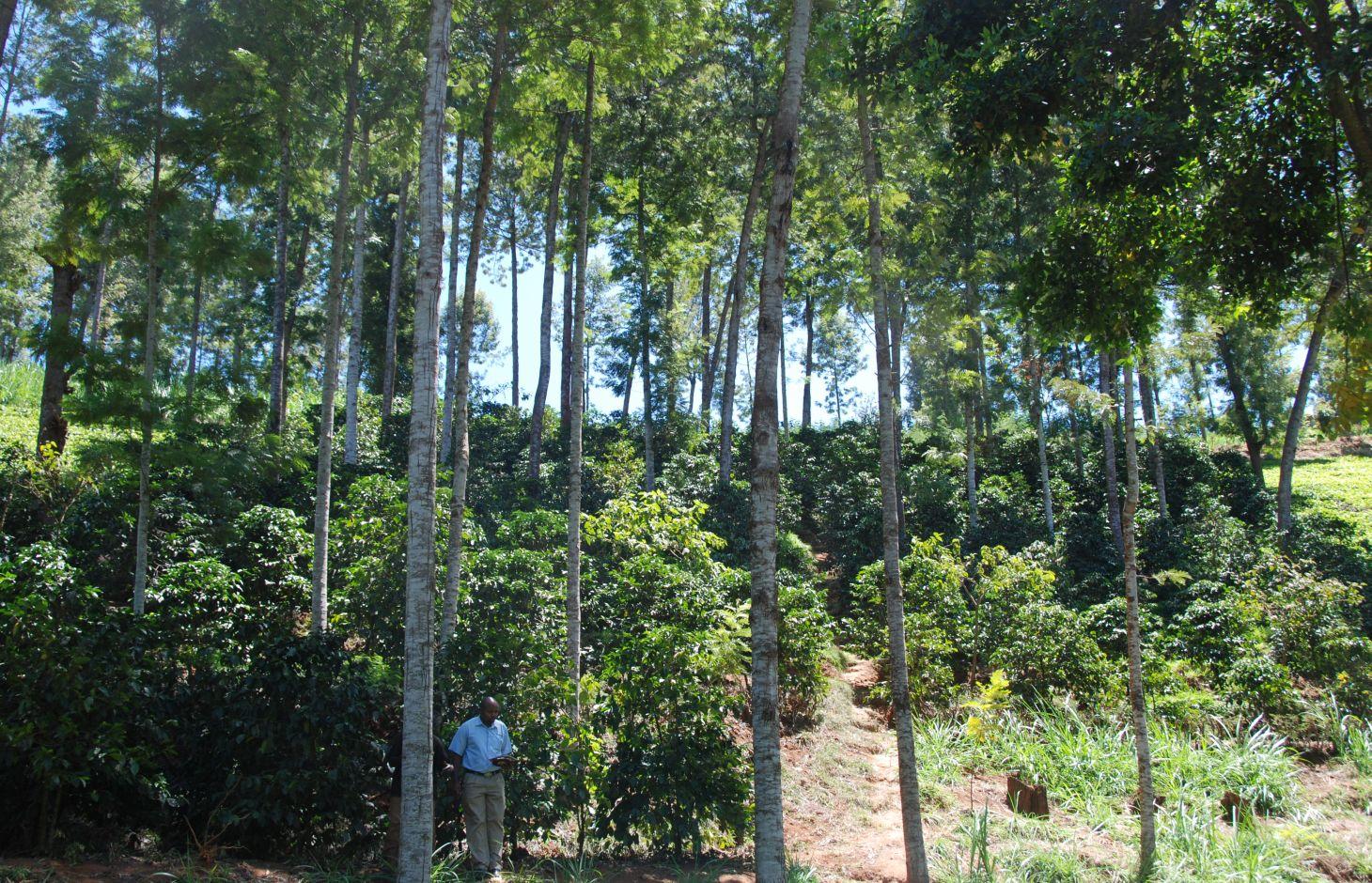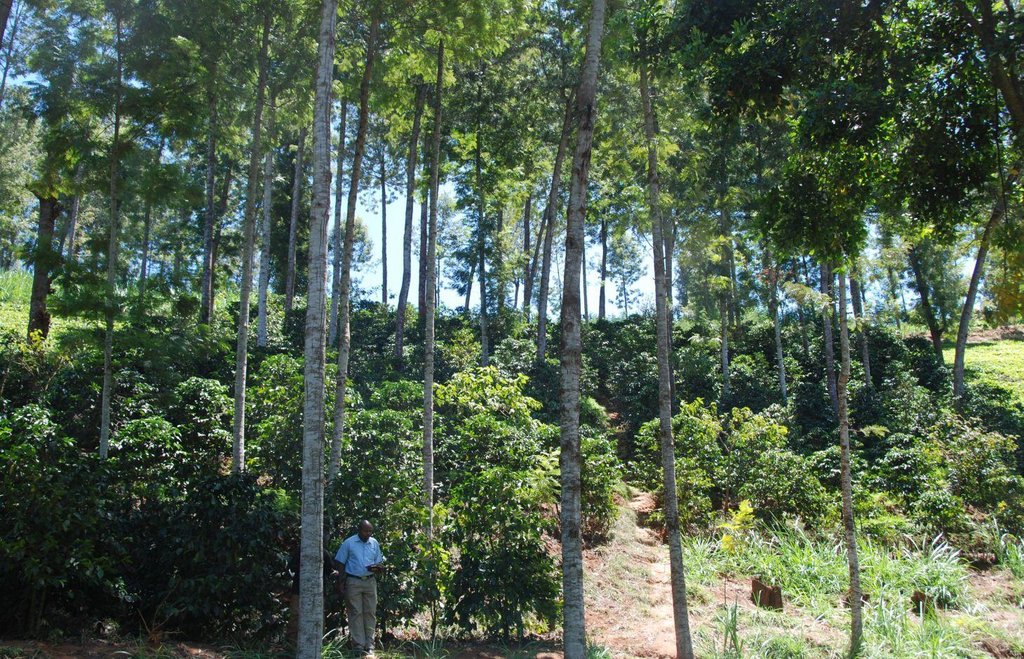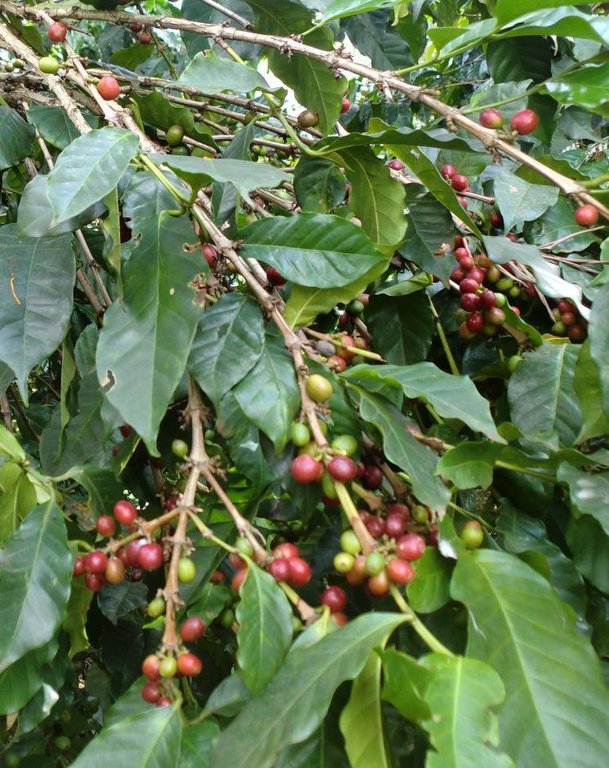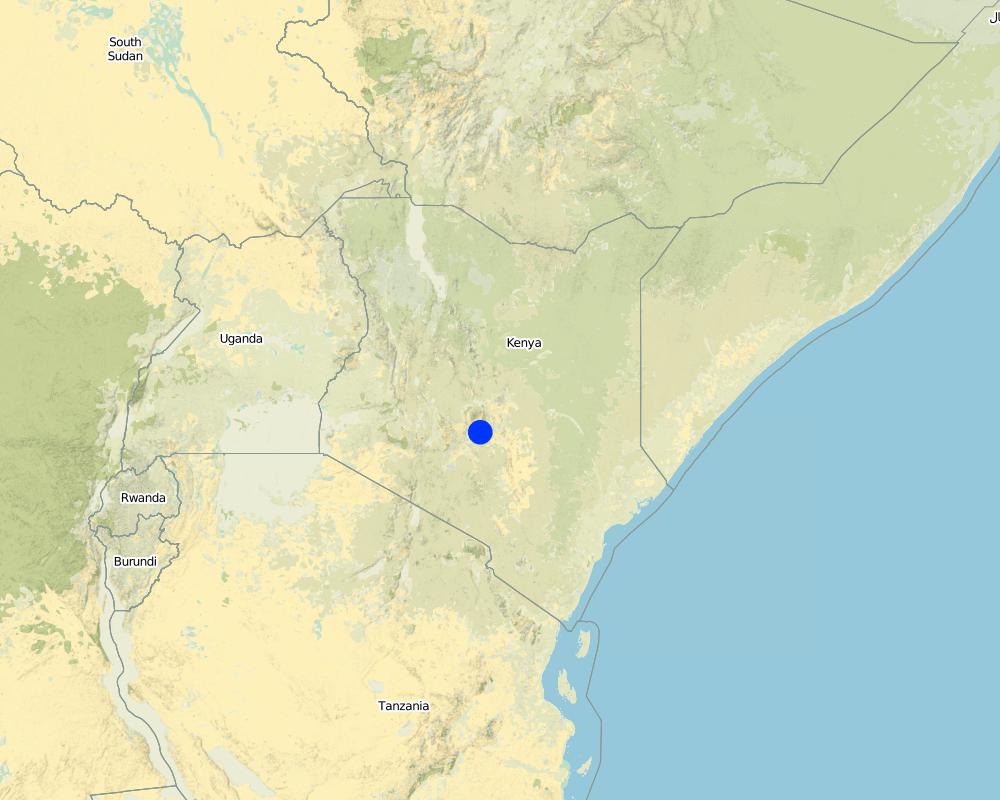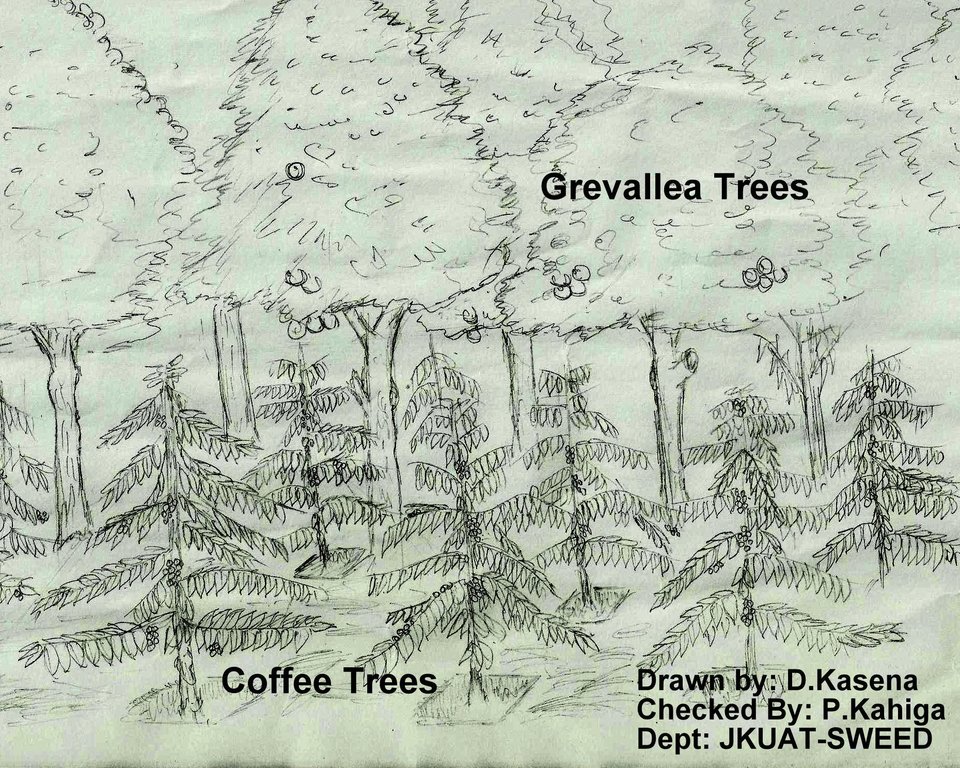Coffee Agroforestry [Kenya]
- Creation:
- Update:
- Compiler: Paul Kahiga
- Editor: –
- Reviewers: Fabian Ottiger, Alexandra Gavilano
Coffee Agroforetry
technologies_1212 - Kenya
View sections
Expand all Collapse all1. معلومات عامة
1.2 Contact details of resource persons and institutions involved in the assessment and documentation of the Technology
SLM specialist:
Gathenya Mwangi
Jomo Kenyatta University of Agriculture and Technology
Kenya
SLM specialist:
Home Patrick
Jomo Kenyatta University of Agriculture and Technology
Kenya
SLM specialist:
Chege Timothy
Jomo Kenyatta University of Agriculture and Technology
Kenya
SLM specialist:
Omwange Abamba
Jomo Kenyatta University of Agriculture and Technology
Kenya
SLM specialist:
Kimengich Baobab
Jomo Kenyatta University of Agriculture and Technology
Kenya
SLM specialist:
Wamuongo Jane
Kenya Agricultural Research Institute
Kenya
SLM specialist:
Karanja Andrew
Kenya Agricultural Research Institute
Kenya
SLM specialist:
Namirembe Sara
World Agroforestry Centre
Kenya
Name of the institution(s) which facilitated the documentation/ evaluation of the Technology (if relevant)
Jomo Kenyatta University (Jomo Kenyatta University) - KenyaName of the institution(s) which facilitated the documentation/ evaluation of the Technology (if relevant)
KARI Headquarters (KARI Headquarters) - KenyaName of the institution(s) which facilitated the documentation/ evaluation of the Technology (if relevant)
International Centre for Research in Agroforestry (ICRAF) - Kenya1.3 Conditions regarding the use of data documented through WOCAT
The compiler and key resource person(s) accept the conditions regarding the use of data documented through WOCAT:
نعم
1.4 Declaration on sustainability of the described Technology
Is the Technology described here problematic with regard to land degradation, so that it cannot be declared a sustainable land management technology?
لا
2. Description of the SLM Technology
2.1 Short description of the Technology
Definition of the Technology:
Land use management system in which coffee is grown around or among crops or pastureland. It combines agricultural and forestry technologies to create more diverse, productive, profitable, healthy, and sustainable land-use systems.
2.2 Detailed description of the Technology
Description:
The success of coffee agro-forestry depends on efficient use of available water and effective strategies to limit tree/crop competition and maximize productivity. On hillsides, planting improved tree/coffee fallows on the degraded upper section of bench terraces is a recommended practice to improve soil fertility while cropping continues on the lower terrace to maintain food production.
Purpose of the Technology: Fewer inputs and less labor required. Shade trees reduce alternate productions, thereby ensuring a more balanced income for coffee farmers. Timber and firewood production improves coffee farmer incomes. By spreading income over several crops, these systems are economically less risky than coffee
monoculture. Financial incentives for pilot projects helping to preserve biodiversity, soils and water quality can be applied, Bonuses are being considered for carbon sequestration in coffee plantations converted from a monoculture to an agroforestry system. The erosion of fragile mountain soils is reduced. Soil fertility is conserved. Exploitation of natural forest reserves is limited. Biological and faunistic diversity is safeguarded.
Establishment / maintenance activities and inputs: Agricultural intensification, moving along the gradient from agroforests grown with a diverse and dense shade canopy to those agroforests with only a few coffee trees to monocultures with only one crop species or cattle pastures, by definition includes a reduction in the planned biodiversity. Agricultural intensification also results in a loss of associated biodiversity. The following key studies in a range of agroforest types and other agricultural systems document losses in associated biodiversity (relative to nearby forest fragments) with increasing agricultural intensification.
Regular maintenance of the terraces through mulching to reduce erosion effects
Natural / human environment: In this technology, there is great intensive extension services through encouraging farmers to adopt it especially in open fields.
2.3 Photos of the Technology
2.5 Country/ region/ locations where the Technology has been applied and which are covered by this assessment
بلد:
Kenya
Region/ State/ Province:
Eastern
Further specification of location:
Embu North
Specify the spread of the Technology:
- evenly spread over an area
If precise area is not known, indicate approximate area covered:
- 1-10 km2
Comments:
Most farmers are nor practicing Coffee Agro-forestry and the few practicing it are getting help of specialized people in the same and the agricultural extension officers fro Ministry of Agriculture (MoA)
Map
×2.6 Date of implementation
If precise year is not known, indicate approximate date:
- 10-50 years ago
2.7 Introduction of the Technology
Specify how the Technology was introduced:
- through land users' innovation
3. Classification of the SLM Technology
3.1 Main purpose(s) of the Technology
- improve production
- reduce, prevent, restore land degradation
- conserve ecosystem
- adapt to climate change/ extremes and its impacts
- create beneficial economic impact
3.2 Current land use type(s) where the Technology is applied
Land use mixed within the same land unit:
نعم
Specify mixed land use (crops/ grazing/ trees):
- Agroforestry

الأراضي الزراعية
- Annual cropping
- Tree and shrub cropping
Tree and shrub cropping - Specify crops:
- coffee, shade grown
Number of growing seasons per year:
- 1

Forest/ woodlands
Type of tree:
- Grevillea robusta
Products and services:
- Timber
- Fuelwood
Comments:
Major land use problems (compiler’s opinion): The effective soil conservation around the agricultural fields brought about by the coffee trees greatly improved land productivity.
Major land use problems (land users’ perception): There is increased yields because of better conservation practices
Future (final) land use (after implementation of SLM Technology): Cropland: Ca: Annual cropping
3.3 Has land use changed due to the implementation of the Technology?
Has land use changed due to the implementation of the Technology?
- Yes (Please fill out the questions below with regard to the land use before implementation of the Technology)

الأراضي الزراعية
- Perennial (non-woody) cropping
3.4 Water supply
Water supply for the land on which the Technology is applied:
- mixed rainfed-irrigated
3.5 SLM group to which the Technology belongs
- agroforestry
3.6 SLM measures comprising the Technology

agronomic measures
- A7: Others

structural measures
- S2: Bunds, banks
Comments:
Specification of other agronomic measures: Coffee and Agroforestry trees
Type of agronomic measures: contour planting / strip cropping, mineral (inorganic) fertilizers, zero tillage / no-till
3.7 Main types of land degradation addressed by the Technology

soil erosion by water
- Wt: loss of topsoil/ surface erosion
Comments:
Main causes of degradation: soil management, Heavy / extreme rainfall (intensity/amounts), land tenure, labour availability
3.8 Prevention, reduction, or restoration of land degradation
Specify the goal of the Technology with regard to land degradation:
- prevent land degradation
4. Technical specifications, implementation activities, inputs, and costs
4.1 Technical drawing of the Technology
Technical specifications (related to technical drawing):
The technical drawing on the left hand side shows a stand of coffee trees planted with agro-forestry trees
Location: Embu. Eastern Province
Date: 13.12.2013
Technical knowledge required for field staff / advisors: moderate (In order to implement this technology, the farmers to contact the front line agricultural extension officers to assist in the correct spacing and planting of the coffee trees in the fields)
Technical knowledge required for land users: high (The planting of coffee trees requires a certain alignment, to avoid blocking of the young and growing crops.)
Main technical functions: control of raindrop splash
Secondary technical functions: reduction in wind speed
Author:
Paul Kahiga, 8444-00300 Nairobi - Kenya
4.3 Establishment activities
| Activity | Timing (season) | |
|---|---|---|
| 1. | Land preparation |
Comments:
Life span of the land preparation: 3 years
4.4 Costs and inputs needed for establishment
| Specify input | Unit | Quantity | Costs per Unit | Total costs per input | % of costs borne by land users | |
|---|---|---|---|---|---|---|
| Labour | Land preparation | ha | 1,0 | 50,0 | 50,0 | 100,0 |
| Equipment | Tools | ha | 1,0 | 70,0 | 70,0 | 100,0 |
| Plant material | Seedlings | ha | 1,0 | 500,0 | 500,0 | 100,0 |
| Fertilizers and biocides | Fertilizer | ha | 1,0 | 400,0 | 400,0 | 100,0 |
| Total costs for establishment of the Technology | 1020,0 | |||||
| Total costs for establishment of the Technology in USD | 1020,0 | |||||
4.5 Maintenance/ recurrent activities
| Activity | Timing/ frequency | |
|---|---|---|
| 1. | Buying of seedlings | once |
| 2. | Digging of holes | once |
| 3. | Planting | once |
| 4. | Prunning | often |
| 5. | Weeding | twice |
4.6 Costs and inputs needed for maintenance/ recurrent activities (per year)
| Specify input | Unit | Quantity | Costs per Unit | Total costs per input | % of costs borne by land users | |
|---|---|---|---|---|---|---|
| Labour | Digging, planting, prunning and weeding | ha | 1,0 | 80,0 | 80,0 | 100,0 |
| Equipment | Tools | ha | 1,0 | 50,0 | 50,0 | 100,0 |
| Plant material | Seedlings | ha | 1,0 | 30,0 | 30,0 | 100,0 |
| Fertilizers and biocides | Fertilizer | ha | 1,0 | 50,0 | 50,0 | 100,0 |
| Total costs for maintenance of the Technology | 210,0 | |||||
| Total costs for maintenance of the Technology in USD | 210,0 | |||||
4.7 Most important factors affecting the costs
Describe the most determinate factors affecting the costs:
labour
5. Natural and human environment
5.1 Climate
Annual rainfall
- < 250 mm
- 251-500 mm
- 501-750 mm
- 751-1,000 mm
- 1,001-1,500 mm
- 1,501-2,000 mm
- 2,001-3,000 mm
- 3,001-4,000 mm
- > 4,000 mm
Agro-climatic zone
- sub-humid
Thermal climate class: tropics
5.2 Topography
Slopes on average:
- flat (0-2%)
- gentle (3-5%)
- moderate (6-10%)
- rolling (11-15%)
- hilly (16-30%)
- steep (31-60%)
- very steep (>60%)
Landforms:
- plateau/plains
- ridges
- mountain slopes
- hill slopes
- footslopes
- valley floors
Altitudinal zone:
- 0-100 m a.s.l.
- 101-500 m a.s.l.
- 501-1,000 m a.s.l.
- 1,001-1,500 m a.s.l.
- 1,501-2,000 m a.s.l.
- 2,001-2,500 m a.s.l.
- 2,501-3,000 m a.s.l.
- 3,001-4,000 m a.s.l.
- > 4,000 m a.s.l.
5.3 Soils
Soil depth on average:
- very shallow (0-20 cm)
- shallow (21-50 cm)
- moderately deep (51-80 cm)
- deep (81-120 cm)
- very deep (> 120 cm)
Soil texture (topsoil):
- medium (loamy, silty)
Topsoil organic matter:
- medium (1-3%)
If available, attach full soil description or specify the available information, e.g. soil type, soil PH/ acidity, Cation Exchange Capacity, nitrogen, salinity etc.
Soil fertility: Medium
Soil drainage/infiltration: Good
Soil water storage capacity: Medium
5.4 Water availability and quality
Ground water table:
5-50 m
Availability of surface water:
good
Water quality (untreated):
good drinking water
5.5 Biodiversity
Species diversity:
- medium
5.6 Characteristics of land users applying the Technology
Market orientation of production system:
- mixed (subsistence/ commercial)
Off-farm income:
- 10-50% of all income
Relative level of wealth:
- average
Individuals or groups:
- individual/ household
Level of mechanization:
- manual work
Gender:
- women
- men
Indicate other relevant characteristics of the land users:
Land users applying the Technology are mainly common / average land users
Population density: 10-50 persons/km2
Annual population growth: 0.5% - 1%
5.7 Average area of land used by land users applying the Technology
- < 0.5 ha
- 0.5-1 ha
- 1-2 ha
- 2-5 ha
- 5-15 ha
- 15-50 ha
- 50-100 ha
- 100-500 ha
- 500-1,000 ha
- 1,000-10,000 ha
- > 10,000 ha
Is this considered small-, medium- or large-scale (referring to local context)?
- medium-scale
5.8 Land ownership, land use rights, and water use rights
Land ownership:
- individual, titled
Land use rights:
- individual
Water use rights:
- individual
5.9 Access to services and infrastructure
health:
- poor
- moderate
- good
education:
- poor
- moderate
- good
6. Impacts and concluding statements
6.1 On-site impacts the Technology has shown
Socio-economic impacts
Production
wood production
risk of production failure
product diversity
land management
Income and costs
farm income
Socio-cultural impacts
SLM/ land degradation knowledge
Improved livelihoods and human well-being
Ecological impacts
Water cycle/ runoff
evaporation
Soil
soil cover
Other ecological impacts
Competition
6.3 Exposure and sensitivity of the Technology to gradual climate change and climate-related extremes/ disasters (as perceived by land users)
Gradual climate change
Gradual climate change
| Season | increase or decrease | How does the Technology cope with it? | |
|---|---|---|---|
| annual temperature | increase | well |
6.4 Cost-benefit analysis
How do the benefits compare with the establishment costs (from land users’ perspective)?
Short-term returns:
positive
Long-term returns:
positive
How do the benefits compare with the maintenance/ recurrent costs (from land users' perspective)?
Short-term returns:
positive
Long-term returns:
positive
6.5 Adoption of the Technology
Comments:
There is a moderate trend towards spontaneous adoption of the Technology
6.7 Strengths/ advantages/ opportunities of the Technology
| Strengths/ advantages/ opportunities in the compiler’s or other key resource person’s view |
|---|
| Timber and firewood production improves coffee farmer incomes. |
| Exploitation of natural forest reserves is limited. |
| Agro-forestry trees create a microclimate propitious to quality coffee production. |
6.8 Weaknesses/ disadvantages/ risks of the Technology and ways of overcoming them
| Weaknesses/ disadvantages/ risks in the compiler’s or other key resource person’s view | How can they be overcome? |
|---|---|
| According to Pacific Island Agro-forestry, coffee grown in the shade takes longer to bear fruit. | Periodic pruning to reduce excessive shading |
| According to ICRAF, shade-based coffee farms produce up to 50 percent less per acre than coffee grown in the open. | Periodic pruning to reduce excessive shading |
| Excessive shading can promote growth of fungal diseases. | Periodic pruning to reduce excessive shading |
7. References and links
7.1 Methods/ sources of information
- field visits, field surveys
- interviews with land users
When were the data compiled (in the field)?
18/09/2012
Links and modules
Expand all Collapse allLinks
No links
Modules
No modules


